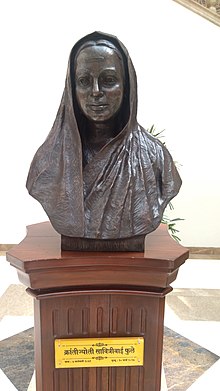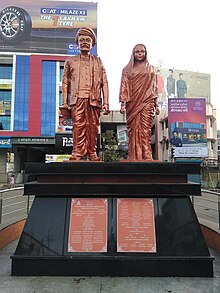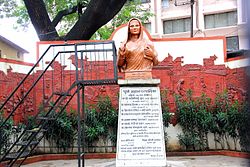Savitribai Jyotirao Phule | |
|---|---|
 Bust of Savitribai Phule. | |
| Born | 3 January 1831 |
| Died | 10 March 1897 (aged 66) |
| Alma mater |
|
| Occupation(s) | Teacher, activist, social reformer |
| Era | 1831- 1897[2] |
| Organization | Satya Shodhak Samaj[3] |
| Known for | Girl's education,[3] Women's emancipation[3] |
| Notable work | • Bavankashi Subhodh Ratnakar [4] |
| Spouse | Jyotirao Phule |
Savitribai Phule () was one of the first female teachers in India,[5] a social reformer, and poet. Along with her husband, Jyotiba Phule in Maharashtra, she played a vital role in improving women's rights in India. She is considered to be the pioneer of India's feminist movement. She strived to abolish discrimination and unfair treatment of people based on caste and gender. She and her husband were pioneers of women's education in India.[6][7] They started their first school for girls in 1848 in Pune at Tatyasaheb Bhide's residence or Bhidewada.[8]
Savitribai Phule was born on 3 January, 1831, in the village of Naigaon in Satara District, Maharashtra. Her birthplace is about 15 km (9.3 mi) from Shirval, and 50 km (31 mi) from Pune.[5] She was the youngest daughter of four children born to Lakshmi and Patil, both of whom belonged to the Mali Community.[9][10] Savitribai married her husband, Jyotirao Phule, at the age of 9 or 10, while he was 13.[11][12][13]
Savitribai was illiterate at the time of her marriage. Her husband educated her and Sagunabai Shirsagar, his cousin sister[clarification needed], at their home while working on their farm.[9][14] Once she completed her primary education with Jyotirao, she continued her studies under the guidance his friends, Sakharam Yeshwant Paranjpe and Keshav Shivram Bhavalkar.[15][16] She enrolled herself in two teachers' training programs; the first was at an institution run by an American missionary, Cynthia Farrar, in Ahmednagar, and the second course was at a Normal School in Pune.[5][9][14] Given her training, Savitribai may have been the first female Indian teacher and headmistress.[5]
After completing her teacher's education, Savitribai Phule started teaching girls at Poona. She did so alongside Sagunabai Kshirsagar, sister of Jyotiba Phule[2] who was a revolutionary feminist and a mentor to Jyotirao.[17] Not long after beginning to teach with Sagunabai, Savitribai and Jyotirao Phule, along with Sagunabai, started their own school at Bhidewada. Bhidewada was the home of Tatya Saheb Bhide, who was inspired by the work that the trio was doing. The curriculum at Bhidewada included a traditional Western curriculum of mathematics, science, and social studies.
By the end of 1851, Savitribai and Jyotirao Phule were running three different schools for girls in Pune. Combined, the three schools had approximately one hundred and fifty students enrolled. Like the curriculum, the teaching methods employed by the three schools differed from those used in government schools. The author Divya Kandukuri believes that the Phule methods were regarded as being superior to those used by government schools. As a result of this reputation, the number of girls receiving their education at the Phules' schools outnumbered the number of boys enrolled in government schools.[9]
Unfortunately, Savitribai and Jyotirao Phule's success came with much resistance from the local community with conservative views. Kandukuri states that Savitribai often travelled to her school carrying an extra sari because she would be assailed by her conservative opposition with stones, dung, and verbal abuse. Savitribai and Jyotirao Phule were living at Jyotirao's father's home. However, in 1839, Jyotirao's father asked the couple to leave his home because their work was considered a sin as per the Manusmriti and its derived Brahmanical texts.[9]
After moving out of Jyotirao's father's home, the Phule's moved in with the family of one of Jyotirao's friends, Usman Sheikh. It was there that Savitribai met a soon-to-be close friend and colleague named Fatima Begum Sheikh. According to Nasreen Sayyed, a leading scholar on Sheikh, "Fatima Sheikh knew how to read and write already, her brother Usman who was a friend of Jyotiba, had encouraged Fatima to take up the teacher training course. She went along with Savitribai to the Normal School and they both graduated together. She was the first Muslim woman teacher of India". Fatima, Savitribai, and opened a school in Sheikh's home in 1849.[9]
In the 1850s, Savitribai and Jyotirao Phule were instrumental in establishing two educational trusts. They were entitled: to the Native Male School, Pune, and the Society for Promoting the Education of Mahar, Mangs, etc. These two trusts ended up encompassing many schools which were led by Savitribai Phule and later, Fatima Sheikh.[9]
Jyotirao summarizes Savitribai and his work in an interview given to the Christian missionary periodical, Dnyanodaya, on 15 September 1853, saying,
It did occur to me that the improvement that comes about in a child due to the mother is very important and good. So those who are concerned with the happiness and welfare of this country should definitely pay attention to the condition of women and make every effort to impart knowledge to them if they want the country to progress. With this thought, I started the school for girls first. But my caste brethren did not like that I was educating girls and my own father threw us out of the house. Nobody was ready to give space for the school nor did we have money to build it. People were not willing to send their children to school but Lahuji Ragh Raut Mang and Ranba Mahar convinced their caste brethren about the benefits of getting educated.[5]

Together with her husband, she taught children from different castes and opened a total of 18 schools.[18] The couple also opened a care center called Balhatya Pratibandhak Griha[6] (transl. Centre to stop child killing) for pregnant rape victims and helped deliver and save their children.[19]
Savitribai and Jyotirao had no children of their own.[11][12] It is said that they adopted Yashawantrao, who was the son of a Brahmin widow. However, there is no original evidence available yet to support this.[6] It is said when Yashwant was about to get married, no one was willing to give him a girl because he was born to a widow. Hence, Savitribai probably arranged his marriage to her organization's worker Dynoba Sasane's daughter in February 1889.[13]
Savitribai and her adopted son Yashwant, opened a clinic to treat those affected by the worldwide Third Pandemic of the bubonic plague when it appeared in the area around Nalasopara in 1897.[20] The clinic was established on the stern outskirts of Pune, in an area free of infection. Savitribai died a heroic death trying to save the son of Pandurang Babaji Gaekwad. Upon learning that Babaji Gaekwad's son had contracted the plague in the Mahar settlement outside of Mundhwa, Savitribai Phule rushed to his side and carried him on her back to the hospital. In the process, Savitribai Phule caught the plague and died at 9:00 pm on 10 March 1897.[5]
Savitribai Phule was also an author and poet. She published Kavya Phule in 1854 and Bavan Kashi Subodh Ratnakar in 1892, and also a poem entitled "Go, Get Education" in which she encouraged those who are oppressed to free themselves by obtaining an education.[citation needed] As a result of her experience and work, she became an ardent feminist. She established the Mahila Seva Mandal to raise awareness for issues concerning women's rights. Savitribai also called for a gathering place for women that was free of caste discrimination or differentiation of any kind.[citation needed] Symbolic of this was that all the women that attended were to sit on the same mat. She was also an anti-infanticide activist. She opened a women's shelter called the Home for the Prevention of Infanticide, where Brahmin widows could safely deliver their children and leave them there to be adopted if they so desired. She also campaigned against child marriage and was an advocate of widow remarriage.[9][21]
In a letter to her husband Jyotirao, Savitribai told the story about a boy about to be lynched by his fellow villagers for having relations with a woman of lower caste when Savitribai intervened. She wrote, "I came to know about their murderous plan. I rushed to the spot and scared them away, pointing out the grave consequences of killing the lovers under British law. They changed their mind after listening to me".[9]


Savitribai Phule's legacy lives on today; her work for girl's and women's education is hugely respected.[22]